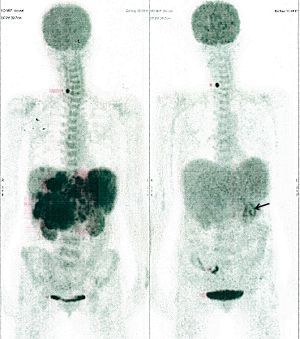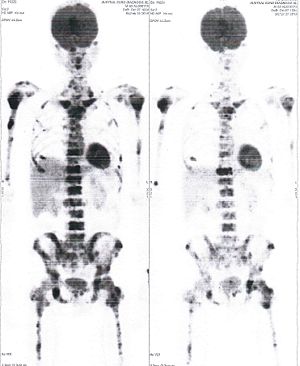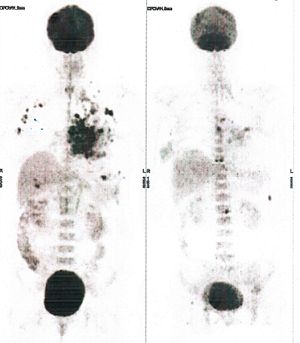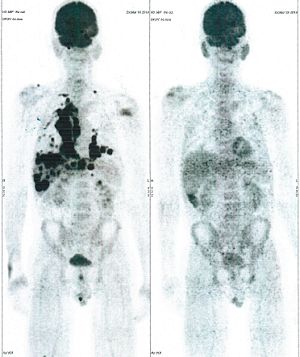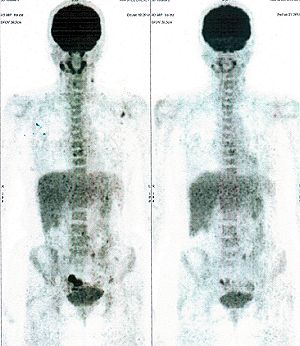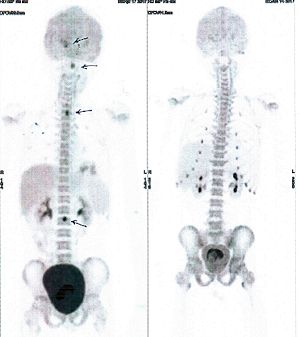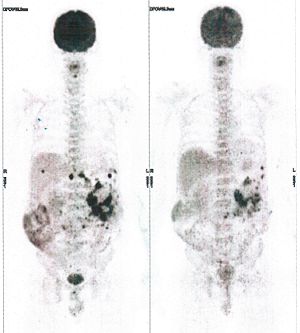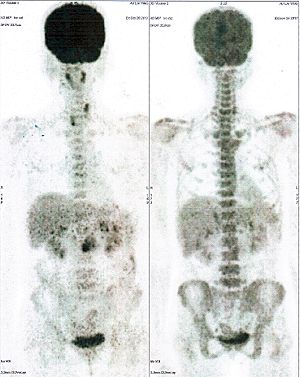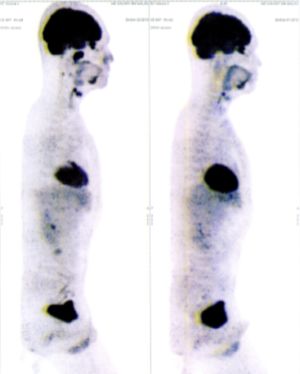Cancer Cases Treated and Results
Below are some of the cases, from more than 80 cases we have treated so far with good results.
When reading the PET/CT scans, the picture on the left is before treatment, and the picture on the right is after treatment.
The intensity of black represents the activity of the cancer, but some black areas are not cancer: brain, heart,
radioactive urine in bladder. For the heart, the intensity of black depends on the number of hours of fasting:
if more than 10 hours, the heart is not even black, but if fasting is less than 6 hours, it is very black.
The intensity of black in the brain can be variable in different scans depending on the brain activity at
the time of the scan. The intensity of black in the radioactive urine can also be variable due to the
hydration of patients and the time of injection of diuretic.
CASE NO: 1
(HEPATOCELLULAR CARCINOMA + STOMACH CANCER)
A middle-aged women who is very thin and very weak, can hardly walk, lying in bed most of the time. She saw
a cancer specialist in a top hospital who discovered that she had massive hepatocellular carcinoma, and another
cancer in the stomach. Given that hepatocellular carcinoma is incurable and stomach cancer is very difficult if not
impossible to cure without surgery, she was told that nothing could be done for her. She came to ask us to
help her. After just 4 treatment, the hepatocellular carcinoma went into remission, and the stomach cancer
(arrow) became less active. Until today, more than 6 months later, the hepatocellular carcinoma is still in
remission.
CASE NO: 1 - A FEW MONTHS LATER
A few months after successful treatment for hepatocellular carcinoma, and partially successful for stomach cancer, the PET/CT scan showed the stomach cancer becoming very active, with
several metastases to the parts of the liver not previously involved by hepatocellular carcinoma. After a few
treatment, all the active stomach cancer lesions in the stomach and in the liver went into remission.
CASE NO: 2 (HEPATOCELLULAR CARCINOMA)
A 40+ man with hepatocellular carcinoma, an incurable cancer. After 2 treatment, the activity of the
hepatocellular carcinoma is less.
CASE NO: 2 (HEPATOCELLULAR CARCINOMA) - After a few more treatments
After another few treatment, the activity of the hepatocellular carcinoma is much less.
The patient never came back for further treatment, but this case, and case
no: 1, shows that incurable hepatocellular carcinoma, often seen in hepatitis B and C patients, can be
cured.
CASE NO: 3 (PROSTATE CANCER)
A middle-aged man with castration resistant prostate cancer, having failed all currently available
cancer treatment, was very weak, and getting worse every day. The PET/CT scan showed he had
massive bone metastases. After a few treatment, all the bone metastases went into remission. About 6
months later, he is still in remission.
CASE NO: 4 (PROSTATE CANCER)
A middle-aged man with castration resistant prostate cancer and massive bone metastases, failed all currently
available cancer treatment, including with the new and expensive drug XTANDI. After a few treatment, most of the
bone metastases went into remission, and the remaining ones are less active. Treatment will continue. Cases
no: 3 and 4 show that terminal prostate cancer today can be cured with our new cancer treatment.
CASE NO: 5 (BREAST CANCER)
A middle-aged woman with breast cancer that has spread to the anterior chest wall, and numerous chemotherapy
could not stop the spread of cancer. After a few treatment, almost all the cancer went into remission. About
6 months later, she is still in remission.
CASE NO: 6 (BREAST CANCER)
A middle-aged women treated for breast cancer now presents with massive liver metastases and a few bone
metastases. She refused conventional chemotherapy and came to see us. After just 2 treatment, most of the
cancer went into remission and those remaining are less active. Treatment will continue until complete
remission.
CASE NO: 7 (BREAST CANCER)
A middle-aged woman treated for breast cancer now presents with bone and liver metastases. After a few
treatment, most of the cancer went into remission, and the remaining ones are less active.
CASE NO: 8 (BREAST CANCER)
A middle-aged women treated for breast cancer now present with bone and right lung metastases. After just
2 treatment, almost all the cancer went into remission, but treatment is continuing to prevent recurrence.
CASE NO: 9 (NHL + LUNG CANCER)
A middle-aged man successfully treated for non-Hodgkin’s lymphoma, came back with massive right lung and
pleural cancer. After just 2 treatment, all the cancer went into remission. Treatment is continuing to prevent
recurrence.
CASE NO: 10 (LUNG CANCER)
An old man with right lung cancer refused all cancer treatment, but was convinced to try our new cancer treatment because there is no severe side effect. After 3 treatment, the cancer shrunk to less than half the original size.
He did not come back to continue the treatment.
CASE NO: 11 (NASOPHARYNGEAL CARCINOMA)
Old women successfully treatment for nasopharyngeal carcinoma, but two years later, she presented with
massive liver and bone metastases while the cancer in the nasopharyngeal region did not recur. After a few
treatment most of the cancer had regressed, and the remaining ones are less active. Treatment will continue
until complete remission.
CASE NO: 12 (ENDOMETRIAL CANCER)
Old women previously treated for endometrial cancer came back with massive metastases in lymph nodes.
After a few treatment almost all the cancer went into remission (the black area in the left abdomen is
radioactive urine in the left kidney: arrow)
CASE NO: 13 (ENDOMETRIAL CANCER)
Middle-aged women previous treated for endometrial cancer came back with massive metastases in lymph nodes,
and in the left pelvic bones. After a few treatment, almost all the metastases went into remission.
CASE NO: 14 (BLADDER CANCER)
Middle-aged man presented with bladder cancer (arrow). His urologist proposed to remove the whole bladder
(radical cystectomy) leaving him with holes in the abdomen wall for urine to come out. He was devastated, so he
came to us for help. After a few treatment, the bladder cancer went into remission. After about 6 months,
the bladder cancer is still in remission, and a cystoscopy done by his urologist confirmed that the cancer
is completely gone.
CASE NO: 15 (OVARIAN CANCER)
Middle-aged women treated for ovarian cancer a few years ago. She now has recurrence with cancer in the
pelvis, and in a small left supraclavicular lymph node. After 2 treatment, most of the cancer went into
remission. Treatment will continue to put all cancer into remission.
CASE NO: 16 (GLIOMA)
Teenage boy with glioma spreading to the spinal cords (arrows) and urinary retention. After a few treatment,
all the cancer went into remission, and there is no more urinary retention.
CASE NO: 17 (PANCREATIC CANCER)
Middle-aged man with pancreatic cancer that has spread to the anterior abdominal wall, and no currently
available treatment can stop the progression. After a few treatment, about half the cancer is gone.
After more treatment, the man was very healthy and led a normal life, but he refused a third PET/CT scan as
he was told that he would get a lot of radiation.
CASE NO: 18 (PANCREATIC CANCER)
A middle-aged woman with pancreatic cancer of the body of the pancreas which is not operable. Chemotherapy
cannot cure such cancer. After just 2 treatment, the cancer went into remission. After 6 months, the women
is in good condition, and treatment is continuing to prevent recurrence.
CASE NO: 19 (PANCREATIC CANCER)
A middle-aged man presented with inoperable pancreatic cancer, with cancer in the uncinate process and in
the tail. After a few treatment, the cancer went into remission. Treatment will continue to prevent
recurrence.
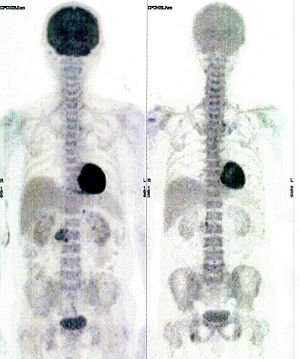
CASE NO: 20 (SMALL CELL LUNG CANCER)
A man around 50 years old has small cell lung cancer which is reputed to be very difficult to treat.
It has spread to the mediastinum and bones, and is resistant to chemotherapy. Other treatment have failed.
After just one treatment, all the cancer in soft tissues have regressed, while bone metastases are less
active. Treatment is continuing.
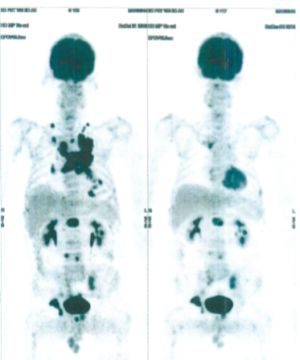
CASE NO: 21 (LUNG CANCER)
A man around 70 years old has left lung cancer but he refused chemotherapy due to the severe side effects.
After a few treatment, the cancer is much smaller and less active. Treatment is continuing.
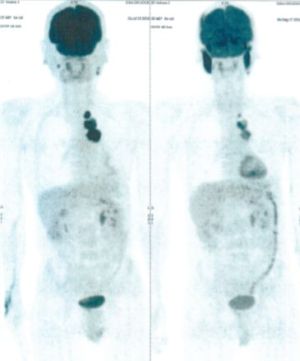
CASE NO: 22 (BREAST CANCER)
A middle-aged woman with breast cancer that has spread to the liver and to the bones, and resistant
to chemotherapy. After some treatment, most of the cancer is in remission. Treatment is continuing.
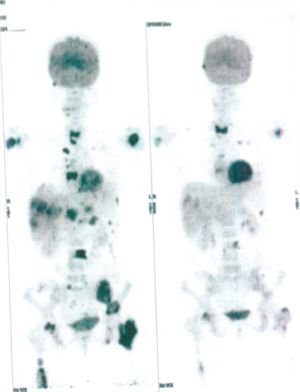
CASE NO: 23 (BREAST CANCER)
A middle-aged woman with breast cancer spreading the bones, and resistant to chemotherapy. After
a few treatment, the bone metastases are much less active.
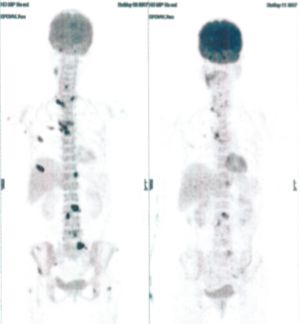
CASE NO: 24 (BREAST CANCER)
A 40+ women was treated for right breast cancer, but it spread to the bones and to the whole of the left
breast. After some treatment, the bone metastases are much less active, and the cancer in the left breast
is also less active. Before treatment, the women could not walk and has severe pain, but after treatment,
she feels normal again, and can walk without assistance. Treatment is continuing.

CASE NO: 25 (BREAST CANCER)
A 60+ women with breast cancer, has extensive liver metastases and some bone metastases. She is
bedridden and very weak. All treatment has failed. After a few treatment, most of the cancer has
become inactive, and she can walk and feet much better.

CASE NO: 26 (LUNG CANCER OR LYMPHOMA)
A 40+ male was found to have active nodes in the mediastinal, right hilar, and right supraclavicular
region. Biopsies were done, but could not decide whether it is lung cancer or lymphoma, so oncologists
could not start treatment. After a few treatment, all the active nodes regressed. This new cancer
treatment does not need biopsy results before treatment, as a combination of five different chemotherapy
drugs can be effective for various kinds of cancer.
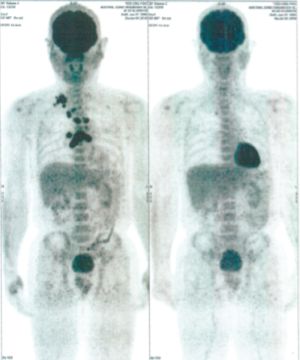
CASE NO: 27 (BREAST CANCER)
A 60+ woman has breast cancer that has spread to the liver and to the bones, and resistant to
chemotherapy. After some treatment, most of the cancer is in remission, with very little cancer left.
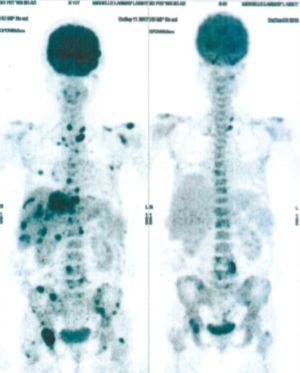
CASE NO: 28 (MASSIVE LIVER METASTASES)
A 50+ woman is very weak and bedridden, with massive liver metastases of unknown origin. After a few
treatment, the cancer in the liver has shrunk by more than half, and the women can walk and feels much
better. Treatment is continuing. This case illustrates again that it is not necessary to know
the histology of the cancer before starting treatment.

CASE NO: 29 (OVARIAN CANCER)
A 40+ women has recurrent ovarian cancer in the lower abdomen, resistant to chemotherapy. After
a few treatment, most of the cancer went into remission with only a small bit left. Treatment is
continuing.

CASE NO: 30 (PROSTATE CANCER)
A 60+ male with castration resistant prostate cancer with bone metastases that have failed all other
treatment, and very weak. After just one treatment, the activity of the bone metastases is much less.
Unfortunately, he passed away some weeks later due to an unrelated cause.

CASE NO: 31 (LUNG CANCER WITH BRAIN METASTASES)
A 40+ woman with lung cancer and brain metastases failed all treatment including radiotherapy and
chemotherapy. She cannot walk. After a few treatment, the left lung cancer is gone, and all the brain
metastases are gone. She is starting to walk again. One set of pictures shows the left lung cancer, and
the other set of pictures show the brain: on top is BEFORE TREATMENT, bottom is AFTER TREATMENT.

CASE NO: 31 AFTER TREATMENT

CASE NO: 32 (BREAST CANCER)
A 50+ year old women with breast cancer has metastases in the sternum, and failed all treatment.
After a few treatment, the metastases in the sternum are gone.

CASE NO: 33 (BREAST CANCER or LYMPHOMA)
A 50+ women treated for breast cancer many years ago. She came back with large abdominal and pelvic
nodes. It could be lymphoma or metastases from her breast cancer. Biopsy would be difficult, but there
is no need to know. After a few treatment, all the malignant lesions are gone.
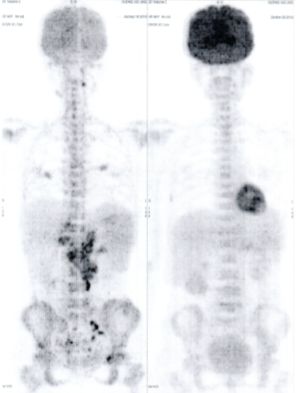
CASE NO: 34 (PERIPHERAL T-CELL LYMPHOMA)
A 50+ year old female has recurrent Peripheral T-Cell Lymphoma that failed all treatment, and it
has spread to lymph nodes in the axillary and mediastinal region, and to the lungs. The specialists
gave her about 3 months to live. After just one treatment, the axillary/mediastinal nodes and the
lung lesions are gone. One set of pictures shows the lymph nodes, and the other set of pictures show
lung lesions. The picture on top is BEFORE TREATMENT, and the picture below is AFTER TREATMENT.

CASE NO: 34 AFTER TREATMENT

CASE NO: 35 (SMALL CELL LUNG CANCER)
A 50+ year old man has quite extensive small cell lung cancer on the right side, that has also spread
to the liver. This cancer is reputed to be very difficult to treat, and it has failed all cancer treatment.
After some treatment, all the cancer in the right lung and liver are gone except for a smaller one
remaining in the right lung. Treatment is continuing.
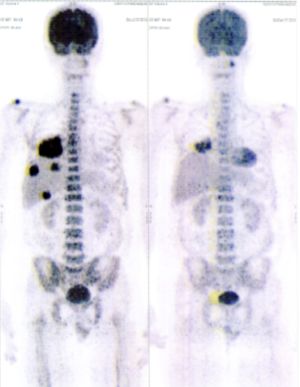
CASE NO: 36 (CERVICAL CANCER)
A 60+ year old woman has extensive cervical cancer, spreading massively to the abdominal/pelvic lymph
nodes, and a few to nodes in the mediastinal, left hilar, and left supraclavicular region. All
cancer treatment failed. After a few treatment, all the cancer is gone except for a small one in
the uterine cervix.
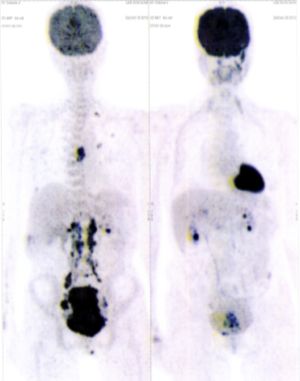
CASE NO: 37 (NASOPHARYNGEAL CARCINOMA)
A 40+ year old man has massive malignant lesions in the nasopharynx, spreading upwards to the bones at
the base of the skull and to the brain, and to large lymph nodes in the cervical and supraclavicular region.
He cannot be treated with radiotherapy that will make him go blind as the lesions are very near the eyes.
He refused chemotherapy. After some treatment, most of the cancer is gone except for a few in the neck
and in bones at the base of the skull. Treatment is continuing.

CASE NO: 38 (NASOPHARYNGEAL CARCINOMA)
A 50+ woman from Germany was treated there by radiotherapy and chemotherapy, but cancer persists
in the nasopharynx, bones at the base of the skull and spreading into the brain. Doctors in Germany
have given up and she was just waiting to die. Then she heard about us and came. After some treatment,
most of the cancer is gone, and the cancer at the base of the skull has very little activity. The woman
is now in good condition, and very happy to be saved.
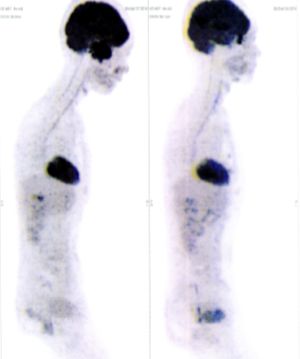
CASE NO: 39 (BREAST CANCER OR LYMPHOMA)
The women in Case 33 above, who was cancer free a few weeks ago, came back with active lesions in
the abdomen/pelvis, left anterior chest wall, and in the right inguinal and left axillary region.
After just one treatment, all the lesions became inactive except for the one in the left anterior
chest wall which is much smaller and much less active.

CASE NO: 40 (NASOPHARYNGEAL CARCINOMA)
A 50+ male has cancer in the nasopharynx, spreading to lymph nodes in the cervical region. He
absolutely refused radiotherapy and chemotherapy. He took alternative medicine for some time but there
was no improvement. Finally, he heard about our treatment. After a few treatment, all the cancer lesions
are gone.
CASE NO: 41 (PANCREATIC CANCER WITH LIVER METASTASES)
A 60+ man with inoperable pancreatic cancer, who later found out that the cancer has spread to the liver.
He was just waiting to die as treatment is very difficult, until he heard about us. After a few treatment,
the pancreatic cancer and the liver metastases went into remission.
